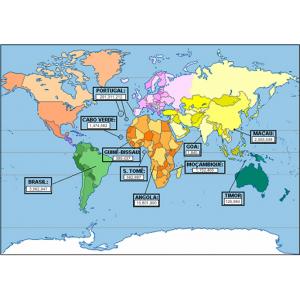Grammar & Resources
The group is centered on modeling linguistic knowledge, integrating interfaces between different areas of grammar and knowledge about how language is put to use. Joint work in formal phonology, lexicon, syntax and semantics allows building an integrated model of grammar, considering how it is represented in the human mind, as well as how it can be computationally modelled; work on L1 and L2 acquisition is at the core of this work. The integration of models of language representation and models of language use is achieved through the study of corpora.
The production of corpora and resources is justified by the goal of developing documentation and providing descriptions of contemporary European Portuguese, but also of understudied contact languages or varieties (Portuguese-based creoles, national varieties of Portuguese in Africa and Asia). The group also produces resources for the study of L1 and L2 acquisition in different settings. The group integrates CLARIN LP.
Research on L1 and L2 acquisition contributes to CLUL’s general purpose of effectively articulating fundamental and applied research, namely in the areas of Educational Linguistics and Clinical Linguistics.
General goals:
- To produce new resources for the study of Portuguese and Portuguese-based creoles;
- To pursue basic research on natural language modeling, integrating knowledge on interfaces between language modules;
- To continue the documentation and description of understudied creoles and new varieties of Portuguese that emerged in a context of language contact;
- To develop the study of language acquisition with an emphasis on language contact situations (see new international Heritage Language Consortium) and on the comparison between typical and atypical development;
- To explore the potential of comparative linguistics in the production of resources for translation and to promote connections with the industry in the area of translation.
Membros
Integrated members with PhD
Integrated members without PhD
Colaboradores
Concluded
| Project | Date | Fin. |
|---|---|---|
| ParlaMint II - ParlaMint II | - | |
| PALMA - Possession and Location: Microvariation in African Varieties of Portuguese (PALMA) | - | FCT
|
| RECAP - RECAP: Resources for Portuguese Learning | - | FCG
|
| CLARIN - CLARIN | - | |
| Documentation of Sri Lanka Portuguese | - | |
| LeCIEPLE - LeCIEPLE - Learner Corpus: da investigação ao ensino de Português Língua Estrangeira/Língua Segunda | - | FCG
|
| Portuguese-based creoles of the Dravidian space: Diachrony and synchrony | - | |
| TAXE - TAXE - Parataxis, Hypotaxis and Interface Syntax-Discourse | - | |
| COPAS - COPAS - Contrast and Parallelism in Speech | - | |
| CLAP - CLAP - Complement clauses in the Acquisition of Portuguese | FCT
|
|
| SynExtract - SynExtract - automatic extraction of synonymy relations for a cost-effective acquisition of language resources | - | FCT
|
| SemiAutLex.PT - SemiAutLex.PT - Semi-automatic construction of relational lexica for Portuguese | - | FCT
|
. (2018). A concordância em expressões nominais coordenadas com apenas um determinante. Revista Da Associação Portuguesa De Linguística 4. |
. (2018). Relativas livres e interrogativas parciais: paralelos e diferenças. Revista Da Associação Portuguesa De Linguística, 4. http://doi.org/https://doi.org/10.26334/2183-9077/rapln4ano2018a38 (Original work published 2018) |
. (2018). Consoantes róticas e variação no português de São Tomé. Revista Da Associação Portuguesa De Linguística, 4. |
. (2018). Error annotation in the COPLE2 corpus. Revista Da Associação Portuguesa De Linguística, 4, 225-239. http://doi.org/10.26334/2183-9077/rapln4ano2018a42 |
. (2019). Connective-lex: A web-based multilingual lexical resource for connectives. Discours, 24. |
. (2020). TED Multilingual Discourse Bank (TED-MDB): a parallel corpus annotated in the PDTB style. Language Resources And Evaluation, 54 (2), 587-613. http://doi.org/https://doi.org/10.1007/s10579-019-09445-9 10579_2019_9445_OnlinePDF-3.pdf457.98 KB
|
. (2018). Formas de tratamento no português europeu e brasileiro. Diadorim: Revista De Estudos Linguísticos E Literários 20, 20, 245-262. |
. (2016). Modalidade e foco: uma análise baseada em dados de corpus. Diadorim – Revista De Estudos Linguísticos E Literários, 127-141. http://doi.org/https://doi.org/10.35520/diadorim.2016.v18n0a4051 |
. (2016). Apresentação do Corpus de Português Língua Estrangeira/Língua Segunda – COPLE2. Revista Da Associação Portuguesa De Linguística, 1, 37-56. http://doi.org/10.21747/2183-9077/rapla3 |
. (2018). A aquisição das consoantes laterais do português europeu por falantes chineses. Revista Da Associação Portuguesa De Linguística, 4, 295-313. http://doi.org/https://doi.org/10.26334/2183-9077/rapln4ano2018a46 |
. (2019). A aquisição das consoantes líquidas do português europeu em coda por falantes chineses. De Oriente A Ocidente: Estudos Da Associação Internacional De Lusitanistas, Volume V — Estudos da AIL sobre Ciências da Linguagem (Língua, Linguística, Didática), 87-118. Retrieved from https://lusitanistasail.press/index.php/ailpress/catalog/view/168/60/739-2 |
. (2018). How Chinese learners of L2 European Portuguese interpret null and overt pronouns in forward and backward anaphora. Revista Linguística. http://doi.org/dx.doi.org/10.31513/linguistica.2018.v14n2a17653 |
. (2015). O português num contexto multilingue: o caso de São Tomé e Príncipe. Revista Científica Da Universidade Eduardo Mondlane: Série Ciências Da Educação, 1, 87-107. (Original work published 2015) |
. (2018). On the Semantics of the Temporal Auxiliary Verb 'ir' (‘go’) in Portuguese. Syntaxe Et Sémantique, 19 [E. Labeau & J. Bres, dirs., La Grammaticalisation des Périphrases en 'Aller' et 'Venir' dans les Langues Romanes], 147-177. Presses Universitaires de Caen. pdf (draft version)433.1 KB
|
. (2019). Effects of syntactic structure on the comprehension of clefts. Glossa: A Journal Of General Linguistics, 4(1): 74. http://doi.org/doi.org/10.5334/gjgl.645 |
. (2019). Semantic features in the acquisition of mood in European Portuguese. Language Acquisition, 26(3). http://doi.org/DOI: 10.1080/10489223.2019.1570203 |
. (2019). The development of vocabulary and grammar: A longitudinal study of European Portuguese-speaking toddlers. Journal Of Child Language, 46(4). http://doi.org/doi:10.1017/S0305000919000060 |
. (2017). Parents’ reports of lexical and grammatical aspects of toddlers’ language in European Portuguese: developmental trends, age and gender differences. First Language, 37(3). http://doi.org/doi:10.1177/0142723716689274 |
. (2016). Comparing heritage speakers and late L2-learners of European Portuguese: verb movement, VP ellipsis and adverb placement. Linguistic Approaches To Bilingualism, 6(3). http://doi.org/oi: 10.1075/lab.14006.san |
. (2016). Syntactic structure and information structure: the acquisition of Portuguese clefts and be-fragments. Language Acquisition, 23(2). http://doi.org/DOI:10.1080/10489223.2015.1067317 |
. (2016). Aspects of the acquisition of object control and ECM-type verbs in European Portuguese. Language Acquisition, 23(3). http://doi.org/DOI: 10.1080/10489223.2015.1067320 |
. (2019). Estruturas Comparativas Complexas: Variação e Desvio e Questões de Tradução. Revista Da Associação Portuguesa De Linguística, 5, 265-286. pdf559.04 KB
|
. (2018). Immersion learning activities: developing communicative tasks in the community. Theory And Practice Of Second Language Acquisition, 4 (1), 23-48. |
. (2019). POR Nível: Construção e validação de um teste de colocação para o Português Língua Estrangeira – resultados de um estudo-piloto. Revista Da Associação Portuguesa De Linguística, 5, 172-189. Retrieved from https://ojs.apl.pt/index.php/RAPL/article/view/10/2 |
. (2016). Subclasses of Temporal and Spatial Phrases in Portuguese – Location vs. Mere Reference. Journal Of Portuguese Linguistics, 15(1): 2 , 1–17. pdf480.79 KB
|
. (2019). The history of sentence negation in the Gulf of Guinea creoles. Journal Of Ibero-Romance Creoles , 2, 55-84. |
. (2016). Fa d’Ambô: from past to present. International Journal Of The Sociology Of Language, 2016(239). http://doi.org/10.1515/ijsl-2016-0009 |
. (2008). Human Microevolution and the Atlantic Slave Trade. Current Anthropology, 49(1), 134-143. http://doi.org/10.1086/524762 |
. (2016). EFFE-Escreves como falas - falas como escreves?. Revue Romane, 51, n.1, 36-69. http://doi.org/10.1075/rro.51.1.02gom |
. (2019). A pontuação: do ensino à avaliação. Revista Da Associação Portuguesa De Linguística, 5, 75-93. |



















































